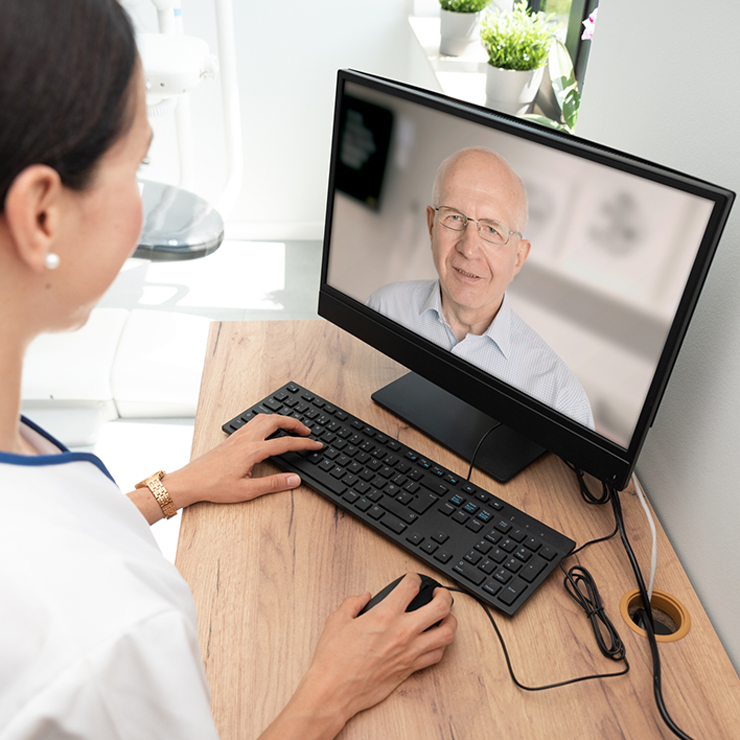 Although popular at the beginning of the twentieth century, the practice of doctors making house calls largely ceased by the 1970s. But now, medical professionals are once again appearing in our living rooms for routine check-ups, outpatient care, and to answer pressing health concerns. This is the result of telehealth solutions: apps and secure video platforms built to connect patients to providers from the comfort of their own homes.
Although popular at the beginning of the twentieth century, the practice of doctors making house calls largely ceased by the 1970s. But now, medical professionals are once again appearing in our living rooms for routine check-ups, outpatient care, and to answer pressing health concerns. This is the result of telehealth solutions: apps and secure video platforms built to connect patients to providers from the comfort of their own homes.
In 2020, the use of telehealth services increased by more than 2,000 percent from January to June, according to a study in JAMA Internal Medicine. That jump has since leveled off, but most patients look forward to a future of telehealth visits. Surveys find that 88 percent of Americans favor using telehealth after the COVID-19 outbreak abates and 75 percent view digital solutions as essential to their care.
But while the pandemic prompted widespread adoption and trust of telehealth services, it has also highlighted the negative effects of virtual interactions and physical isolation. At our core, humans are social creatures. When we feel ill, a hand to hold or a reassuring hug can be transformative.
As digital advances in health care progress, it's crucial to center human touch in the medical field. It's one way to guarantee innovation aimed at improving patients' experiences and outcomes doesn't inadvertently become a distraction from them. Below are three major benefits to sustaining or enhancing personal interactions with patients—especially when paired with new technology.
1. Human Touch Has Its Own Healing Powers.
From an early age, being held promotes healthy development. A 2011 study of touch in the first year of a baby's life demonstrated that skin-to-skin contact with newborns can help regulate their body temperature, heart rate, and breathing.
As we age, regular massage therapy can similarly decrease heart rate, blood pressure, and cortisol levels, according to a study by the Touch Research Institute in ScienceDirect. With loved ones, touch is vital to building relationships and warm, fuzzy feelings—cuddling has been shown to increase a person's level of oxytocin a.k.a. “the joy hormone."
In hospital settings, touch can reassure patients undergoing procedures or experiencing stress. It also numbs feelings of pain. Researchers in 2006 reviewed MRI scans of women in pain when they were alone, holding hands with a stranger, and holding hands with their romantic partners. Pain reactions were highest when a participant was alone and lowest when holding the hand of someone they loved.
Technology in the medical field can streamline processes like prescription refills, sharing medical charts between providers, and scheduling appointments, but it's unlikely to replicate these innate powers of touch.
2. Human Touch Builds Patient-Doctor Confidence.
Beyond physiological responses to human contact, interactions with doctors can simply make patients more at ease when sharing health concerns and personal details. A pat on the back might make someone feel their needs are really being acknowledged. Of course, consent is always necessary in such situations. Making assumptions about a patient's comfort level can backfire, leaving them with a negative experience and delaying medical care.
But respecting patients' boundaries doesn't mean sending test results or difficult diagnoses through an impersonal email (or in one infamous case, delivered by a rolling video-link “robot"). More than ever, good bedside manners can provide calm during uncertain times. Demonstrating empathy, compassion, and support improves patient satisfaction, and in some cases, leads to better health outcomes.
In a recent Harvard Business Review op-ed, Daniel Marchalik, medical director of Physician Well-Being at MedStar Health in Washington, D.C., urges technology creators to center both the patient experience and doctors' needs. He argues that reliance on telehealth services can cause greater burnout in providers, eroding their ability to care for patients. The best technology strengthens the patient-doctor relationship, rather than impedes it.
3. Human Touch Improves and Supplements Technology Advances.
A majority of digital health care solutions are less than a decade old. Disease-identifying algorithms and artificially intelligent MRI scan readers have immensely improved accuracy in the field, but there is always room for improvement. There are still cases of medical technology misdiagnosing illnesses and failing to identify certain symptoms.
No matter how accurately these programs identify miniscule cancer cells, diagnose rare diseases, and never falter due to lack of sleep, patients still trust human providers more. Keeping this in mind will help incorporate new technology into annual appointments, treatments, and outpatient care while maintaining patient safety and confidence.
As far as telehealth visits go, medical professionals say the distance can mean missing certain health concerns like heart problems or the underlying cause of chronic pain. Listening to someone's explanation of chest pain is not the same as listening to their heart with a stethoscope. Other doctors cite the absence of the exam's “ritual."
“There's something about going through a history and being examined—and that ritual provides real comfort and meaning to both a physician and to the patient," Dr. Paul Hyman, of the Maine-based Mid Coast Medical Group, told NPR.
Looking Forward
A growing body of evidence suggests that health care technology is best used in tandem with traditional care. Artificial intelligence and video chat services cannot mimic the benefits of human touch in the medical field, but they can allow overwhelmed providers the space to focus on the patients in front of them.
Telehealth use has stabilized since peaking in 2020, but it's here to stay—the market is estimated to surpass $200 billion by 2030. As innovation continues to grow at dizzying rates, experts recommend providers follow a few guidelines to maintain the quality of care provided:
Develop criteria for determining which patients need in-person or telehealth care. These can be based on a patient's medical history, current symptoms, or on which services can be carried out remotely.
Follow recommendations from trusted sources, like the CDC and the Department of Health and Human Services.
Preserve patients' confidentiality by evaluating the secureness of virtual platforms and conducting visits from a private space.
Create a system to evaluate the effectiveness of virtual care—assess metrics like visit length, patient satisfaction, and video quality.
 Find ways to connect with patients in vulnerable populations, such as those who do not have easy access to a phone or computer in order to utilize virtual care.
Find ways to connect with patients in vulnerable populations, such as those who do not have easy access to a phone or computer in order to utilize virtual care.
The bottom line? No matter how far technology advances in the health care industry, there will always be a place for human touch. It is invaluable and will forever linger.
Joel Landau is founder and chairman of The Allure Group.